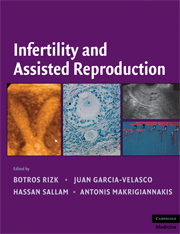Book contents
- Frontmatter
- Contents
- Contributors
- Foreword
- Preface
- Introduction
- PART I PHYSIOLOGY OF REPRODUCTION
- 1 Folliculogenesis: From Preantral Follicles to Corpus Luteum Regression
- 2 Mechanisms of Follicular Development: The Role of Gonadotrophins
- 3 Human Follicle Culture In Vitro
- 4 Endometrial Receptivity
- 5 Molecular Mechanisms of Implantation
- PART II INFERTILITY EVALUATION AND TREATMENT
- PART III ASSISTED REPRODUCTION
- PART IV ETHICAL DILEMMAS IN FERTILITY AND ASSISTED REPRODUCTION
- Index
- Plate section
- References
2 - Mechanisms of Follicular Development: The Role of Gonadotrophins
from PART I - PHYSIOLOGY OF REPRODUCTION
Published online by Cambridge University Press: 04 August 2010
- Frontmatter
- Contents
- Contributors
- Foreword
- Preface
- Introduction
- PART I PHYSIOLOGY OF REPRODUCTION
- 1 Folliculogenesis: From Preantral Follicles to Corpus Luteum Regression
- 2 Mechanisms of Follicular Development: The Role of Gonadotrophins
- 3 Human Follicle Culture In Vitro
- 4 Endometrial Receptivity
- 5 Molecular Mechanisms of Implantation
- PART II INFERTILITY EVALUATION AND TREATMENT
- PART III ASSISTED REPRODUCTION
- PART IV ETHICAL DILEMMAS IN FERTILITY AND ASSISTED REPRODUCTION
- Index
- Plate section
- References
Summary
INTRODUCTION
Folliculogenesis in women is a dynamic and uninterrupted process from fetal life until menopause. Following pubertal maturation of the reproductive axis, all types of follicles from the primordial to the preovulatory stage are present in the human ovary. Over the past twenty years, it has become clear that these follicles represent sequential forms of the developmental process classified into eight categories, based on the size and the number of the granulosa cells (Gougeon, 1986). For example, class 1 corresponds to a secondary preantral follicle and class 8 to a large preovulatory follicle.
Folliculogenesis is a lengthy process (Figure 2.1). Based on the calculation of the doubling time of granulosa cells, it is estimated that the time spent from the primordial to the preovulatory stage is approximately one year (Gougeon, 1986). However, maturation of a follicle from class 1 to class 8 is achieved within eighty-five days (Gougeon, 1986). At the beginning, proliferation of the granulosa cells on several layers takes place and the primordial follicle becomes preantral. Following this, the theca interna develops and the antral cavity is formed. The rate at which follicles leave the primordial pool is not known. However, it seems that the departure follows an ordered sequence, so that follicles formed first leave the pool earlier (Hirshfield, 1991).
It remains unclear which factors are responsible for the initiation of maturation of a primordial follicle or what is the trigger for the passage of a follicle from the preantral to the antral stage (Figure 2.1).
Keywords
- Type
- Chapter
- Information
- Infertility and Assisted Reproduction , pp. 10 - 24Publisher: Cambridge University PressPrint publication year: 2008
References
- 1
- Cited by



